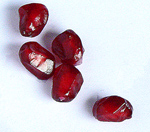Minoan Crete: 1500 BC
Pomegranate seeds and the Minoan 'Ring of Minos', Crete
Gold ring: Late Minoan I, Knossos, Crete. c. 1500 BC.
Apples and pomegranates have been cultivated in southern Europe for millennia.


Apples and pomegranates bear a lot of similarities to each other, so long as you don't open them up,' said Miranda. 'But when you do, you can see how a pomegranate is made up of hundreds of little red seeds. Completely dissimilar to the inside of an apple.'
'But a fruit none the less,' said Quintin.
'A fruit none the less,' agreed Miranda. 'And if you were to ask me what I think is the most striking thing about the Ring of Minos...'
'... the gold ring that was discovered near the Palace of Minos at Knossos on Crete in 1928 and proved at the turn of this century to be genuinely from the Minoan civilisation of the Bronze Age...' interrupted Quintin.
'...then it is that these things which have been interpreted as stones falling into the sea...'
'...like boulders on a seashore?' interrupted Quintin again, squinting at the photographic reproduction...'
'... could just as easily be pomegranate seeds.'


And there is a feeling of circularity to the picture,' continued Miranda, enthusiastically. 'A man is reaching up into a tree, just to the right, while the matriarchal figure in the flounced skirt looks on. Over to the left, a lady looks as though she is descending from another tree. The male figure is obviously picking fruit. And if we let our eye travel from the flowing lines of the male figure reaching into the tree to the lady descending from her tree, we follow a boat that seems to have some sort of peculiar shrine near the bow and our eye moves around again to the seated matriarch who is looking at the male figure and around again in the same circle; around and around. And cutting across this circle of movement, as though they were falling from the trees, are these objects like stones.
'The pomegranate seeds.'
'Yes, I think it is possible. And this ring was probably put on the finger of a dead person, given that it was found near a royal tomb of the period and given that similar rings have been found associated with graves,' explained Miranda. 'So wouldn't it be sensitive to the memory of the deceased, and reassuring to the relatives, to show a journey in a magical boat as part of a never-ending cycle of life and death, watched over by a goddess who seems to be in charge of it all and with pomegranate seeds thrust into the foreground, like the one that Percephone was tricked into eating before returning to the upper world from Hades?
'Both apples and pomegranates have been cultivated in southern Europe for millennia. It was by eating an apple from the Tree of Knowledge that Eve was ejected from the Garden of Eden into the real world. It was through eating a pomegranate seed that Percephone was forced by Hades to have to travel back to the underworld again, every year, from the world above, before returning back into the upper world every time.'
